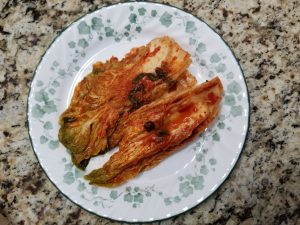One dish that is important to me and my culture is baechu kimchi, or cabbage kimchi, a form of kimchi that involves fermenting napa cabbage with Korean radish, red pepper flakes, jeotgal (salted seafood preserves), and other vegetables such as garlic and green onions. Even though there are reportedly over 200 types of kimchi, for me baechu kimchi stands out above all others as the earliest memories I have of eating involve homemade baechu kimchi. It has a distinct red-orange color and a pungent, tangy smell from the red chili flakes and fermentation. The unique flavor, a combination of the spicy kick from the red pepper flakes and the salty, tangy taste from fermentation, in conjunction with the crunch from the cabbage, is something I never get tired of, and especially crave after eating foods that are too greasy.
In particular, my mom’s baechu kimchi is arguably one of the most important foods in my life, whose familiar flavors and texture kept loving and connected to Korean culture even though we were over 7,000 miles away from home. When I was five, my family had to leave South Korea to the United States as my father had decided to work overseas. As a Korean family in a foreign land with no intention of eating “junk food” like hamburgers and fries for most of our days, my mom, who has a passion for cooking, decided that one of the first things we had to do after unpacking was to create a good supply of baechu kimchi. As we lived in Athens, Georgia at the time, a city not known to have any good Asian supermarkets, I remember that once a month, when my mother deemed our baechu kimchi supply low, that our family would make an hour-long journey to Asian marts in Duluth and Buford to buy one or two huge boxes filled with napa cabbages. The day after grocery shopping was, as my mom called it, ‘kimchi making day,’ where she would bring out a huge plastic bin to transform the boxes of green cabbage into one or two months’ worth of baechu kimchi. As this process took the entire day, the burning, pungent smell of the garlic and the red chili powder would eventually take over the entire house, enveloping the furniture, and, unfortunately, my clothes. I learned to endure these days as the mountain of baechu kimchi that resulted from this long endeavor more than made up for the unpleasant smells during the manufacturing process. As my little brother and I grew older, my mom would allow us to help her make baechu kimchi, ordering us to lift large bins full of salted cabbage while she prepared the red pepper paste mixture that would coat the cabbage. Thanks to my mom’s insistence on making homemade kimchi, as I grew up in the States, baechu kimchi has been beside me like an old friend, constantly reminding me about both my heritage and brings up memories of the various Korean meals I have shared with my family. To this day, even though most people buy their baechu kimchi at the store, due to growing up on my mom’s baechu kimchi, all other baechu kimchi fall short in terms of flavor or texture to me.
With regards to its cultural importance, kimchi is regarded as a national dish of Korea, with some variation of kimchi being served in almost every Korean meal. Today baechu kimchi is by far the most common form of kimchi available and has even become synonymous with the term kimchi itself. Kimchi in various forms has been around the Korean peninsula for over 4,000 years, as during Korea’s Three Kingdoms period (4th to 7th century, A.D.), where, as recorded by their Chinese neighbors, Koreans often salted vegetables for preservation. Before refrigerators, freshly made kimchi was placed into large earthenware pots called onggi and buried underground to start the process of fermentation. While kimchi became prominent in the Korean peninsula after the adoption of Buddhism and its vegetarian diet by the Korean people during the Silla dynasty (57 B.C. to 935 A.D.), the early forms of kimchi were simply salted vegetables but diversified over time to include seasonings like garlic and ginger. It was not until the late 16th to early 17th century during the Joseon dynasty that red peppers were introduced to East Asia through Portuguese traders. Furthermore, napa cabbage was introduced to the Korean peninsula in the 19th century, making baechu kimchi a more recent form of Korean kimchi. Baechu kimchi, while it can be eaten in all seasons thanks to the refrigerator, was originally intended to eat in the fall, when farmers harvested napa cabbage. During Kimjang, a Korean cultural tradition in late fall, for one month families, friends and neighbors would gather together and make enough kimchi to last the winter season. The preparation for Kimjang takes place yearly, as during the spring, families buy seafood to incorporate into the kimchi, such as shrimp and anchovies, and during the summer, they buy sea salt. Red pepper is then dried in late summer before the Kimjang process begins.
Pictures:


Recipe:
Ingredients:
- Two large sized napa cabbage
- 1 Korean radish chopped into thin 3 inch sticks
- 1 1/2 cup kosher salt
- 5 cups of red pepper flakes
- 1 cup shrimp jeotgal
- 1 minced onion (about 1 cup)
- 1 cup garlic
- 1 tablespoon of minced ginger
- 10 stalks of chopped green onion
- 1 cup carrots sliced into thin 3 inch sticks
- 1/4 cup sweet plum extract
- 1/2 Minced apple
- 1/2 cup sweet rice flour
- 3 cups of water
Steps:
- Cut cabbages in half, wash with water
- Put salt inside the leaves of the cabbage, then place into a container for 2 hours
- Turn the cabbage pieces after 2 hours to ensure even salting, leave cabbage for another 2 hours
- Rinse cabbage with cold water about three times
- While the cabbage is getting ready, put 1/2 cups of sweet rice flour and 3 cups of water into a pot, cook over medium-high heat while stirring, stop when bubbles are present, let it cool
- Pour the mixture into a bowl, add Korean radish, red pepper flakes, shrimp jeotgal, garlic, onion, ginger, green onion, carrots, apple, sweet plum extract, and mix well
- Spread this kimchi mixture on each leaf of the cabbage, place tightly in a container to go into the refrigerator for fermentation
